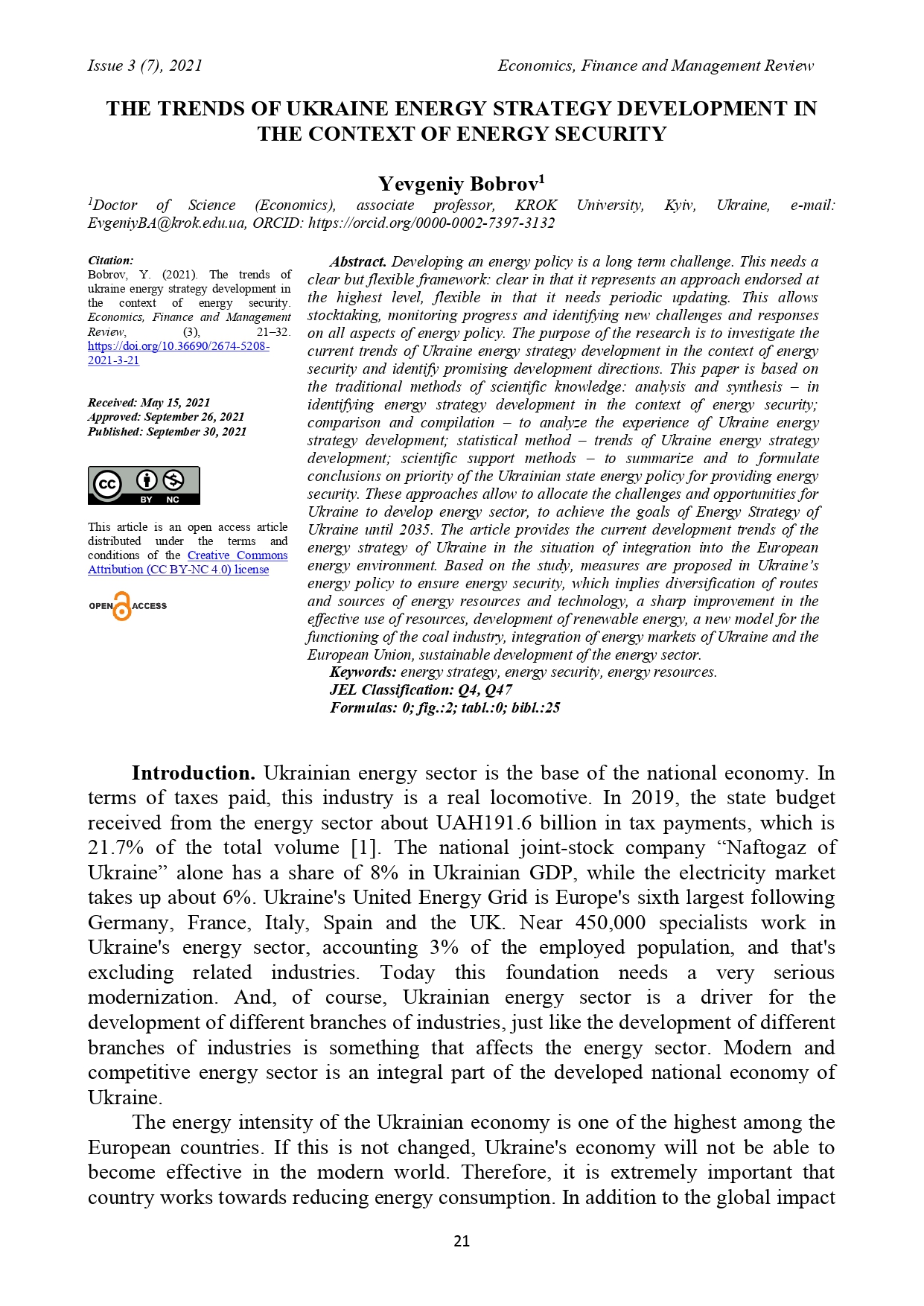THE TRENDS OF UKRAINE ENERGY STRATEGY DEVELOPMENT IN THE CONTEXT OF ENERGY SECURITY
DOI:
https://doi.org/10.36690/2674-5208-2021-3-21Keywords:
energy strategy, energy security, energy resourcesAbstract
Developing an energy policy is a long term challenge. This needs a clear but flexible framework: clear in that it represents an approach endorsed at the highest level, flexible in that it needs periodic updating. This allows stocktaking, monitoring progress and identifying new challenges and responses on all aspects of energy policy. The purpose of the research is to investigate the current trends of Ukraine energy strategy development in the context of energy security and identify promising development directions. This paper is based on the traditional methods of scientific knowledge: analysis and synthesis – in identifying energy strategy development in the context of energy security; comparison and compilation – to analyze the experience of Ukraine energy strategy development; statistical method – trends of Ukraine energy strategy development; scientific support methods – to summarize and to formulate conclusions on priority of the Ukrainian state energy policy for providing energy security. These approaches allow to allocate the challenges and opportunities for Ukraine to develop energy sector, to achieve the goals of Energy Strategy of Ukraine until 2035. The article provides the current development trends of the energy strategy of Ukraine in the situation of integration into the European energy environment. Based on the study, measures are proposed in Ukraine’s energy policy to ensure energy security, which implies diversification of routes and sources of energy resources and technology, a sharp improvement in the effective use of resources, development of renewable energy, a new model for the functioning of the coal industry, integration of energy markets of Ukraine and the European Union, sustainable development of the energy sector.
Downloads
References
Rating. Business in official figures. The structure of tax payments in the fuel and energy sector. 02/27/2020. Available at: https://rating.zone/struktura-podatkovykh-platezhiv-u-palyvno-enerhetychnomu-kompleksi-2/ [in Ukrainian].
Yergin D. (2006). Ensuring Energy Security. Foreign Affairs. Volume 85, #2, 69-82. Available at: http://www.un.org/ga/61/second/daniel_yergin_energysecurity.pdf
Kalicki J., Goldwyn D. (2005). Energy and Security: Toward a New Foreign Policy Strategy 604 р. Washington–Baltimore: Woodrow Wilson Center Press, Johns Hopkins University Press.
Shidlovsky A. (Ed.) (2001). Fuel and energy complex of Ukraine on the threshold of the third millennium. Kyiv, UES [in Ukrainian].
European Commission (2014). Communication from the Commission to the European Parliament and the Council. European Energy Security Strategy. Available at: https://eur-lex.europa.eu/legal-content/EN/TXT/PDF/?uri=CELEX:52014DC0330&from=EN
European Commission (2011). Communication from the Commission to the European Parliament, the Council, the European Economic and Social Committee and the Committee of the Regions on security of energy supply and international cooperation - "The EU Energy Policy: Engaging with Partners beyond Our Borders". Available at: https://eur-lex.europa.eu/legal-content/EN/TXT/PDF/?uri=CELEX:52011DC0539&from=EN
European Commission (2014). Commission staff working document. In-depth study of European Energy Security Accompanying the document Communication from the Commission to the Council and the European Parliament: European energy security strategy. Available at: https://ec.europa.eu/energy/sites/ener/files/documents/20140528_energy_security_study.pdf
European Commission (2018). Imports and secure supplies. Available at: https://ec.europa.eu/energy/en/topics/imports-and-secure-supplies
European Commission (2013). Report from the Commission to the European Parliament, the Council and the European Economic and Social Committee Implementation of the Communication on Security of Energy Supply and International Cooperation and of the Energy Council Conclusions of November 2011. Available at: https://eur-lex.europa.eu/legal-content/EN/TXT/PDF/?uri=CELEX:52013DC0638&from=EN
Khatib H., Barnes A., Chalabi I., Steeg H., Yokobori K. (2000). World energy assessment: energy and the challenge of sustainability, 111-134. Available at: http://www.undp.org/content/dam/aplaws/publication/en/publications/environment-energy/www-ee-library/sustainable-energy/world-energy-assessment-energy-and-the-challenge-of-sustainability/World%20Energy%20Assessment-2000.pdf
International Energy Agency (2018). Energy security. Available at: https://www.iea.org/topics/energysecurity
Denchev K. (2010). World energy security: history and prospects. New and recent history. #2. 34-77. Available at: http://www.hist.msu.ru/Journals/NNI/pdfs/Denchev_2010.pdf [in Russian].
González Arencibia I., Bobrov Y. (2007). EU and Ukraine Security of Energy Supply. Comparative Analysis. UNDP Blue Ribbon Analytical and Advisory Centre. Energy Policy Team.
Lyubashenko I. (2012). Ukraine’s First Year in the Energy Community: Restart Needed. Polish Institute of International Affairs. Available at: https://www.pism.pl/files/?id_plik=10131
Sukhodolia O., Bobro D., Butrimas V., Hajek J., Karasov S. (2018). Hybrid Warfare Against Critical Energy Infrastructure: The Case of Ukraine. NATO Energy Security Centre of Excellence.
Kondratov S., Bobro D., Horbulin V. (2017). Developing the critical infrastructure protection system in Ukraine. National Institute for Strategic Studies [in Ukrainian].
Sendich E. (2014). Comparison of International Energy Intensities Across the G7 and Other Parts of Europe, Including Ukraine. U.S. Energy Information Administration. Available at: https://www.eia.gov/workingpapers/pdf/international_energy_Intensity.pdf
Zachmann G. (2018). The Clock Is Ticking: Ukraine’s Last Chance to Prevent Nord Stream 2. Bruegel. Available at: http://bruegel.org/2018/01/the-clock-is-ticking-ukraines-last-chance-to-prevent-nord-stream-2
Healey J., Cantos M. (2015). What’s next for Putin in Ukraine: Cyber escalation? NATO Cooperative Cyber Defense Centre of Excellence, 153-158. Available at: https://ccdcoe.org/uploads/2018/10/Ch17_CyberWarinPerspective_Healey_Cantos.pdf
Pirani S. (2017). Adversity and reform: Ukrainian gas market prospects. The Oxford Institute for Energy Studies. Available at: https://www.oxfordenergy.org/wpcms/wp-content/uploads/2017/03/Adversity-and-reform-Ukrainian-gas-market-prospects-OIES-Energy-Insight.pdf
Logatskiy V. (2017). New Energy Strategy of Ukraine Till 2035: Security, Energy Efficiency, Competitive Ability. Razumkov Center. Available at: http://razumkov.org.ua/uploads/article/2017_NES%202035_RazumkovCentre_Ukraine_September%202017_description.pdf
Radeke, M., Naumenko, D. (2012). Towards Higher Energy Efficiency in Ukraine: Reducing Regulation and Promoting Energy Efficiency Improvements. German Advisory Group, Institute for Economic Research and Policy Consulting.
Lakyda P., Geletukha G., Vasylyshyn R. et al. (2011). Energy Potential of Biomass in Ukraine. Institute of Forestry and Landscape Park Management of the National University of Life and Environmental Sciences of Ukraine.
Verkhovna Rada of Ukraine. Energy Strategy of Ukraine until 2035 “Safety, Energy Efficiency, Competitiveness”. Available at: http://zakon.rada.gov.ua/laws/show/605-2017-%D1%80 [in Ukrainian].
State Statistics Service of Ukraine (n.d.). Energy balance of Ukraine 2007–2016. Available at: http://www.ukrstat.gov.ua/ [in Ukrainian].

Downloads
Published
How to Cite
Issue
Section
License

This work is licensed under a Creative Commons Attribution-NonCommercial 4.0 International License.








